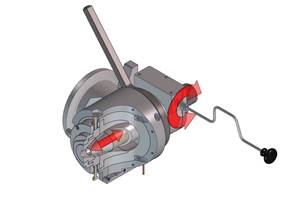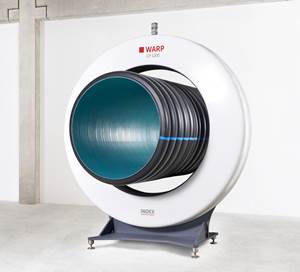Wood-Fiber Adds Stiffness and Value To Tight-Tolerance Tubes
Hollow tubing with a high loading of wood fiber is one of the newest products—and one of the trickiest—in the booming business of wood-filled thermoplastic extrusion.
Hollow tubing with a high loading of wood fiber is one of the newest products—and one of the trickiest—in the booming business of wood-filled thermoplastic extrusion. At least two custom processors have commercialized such tubing in the past two years. Both use precompounded pellets in single-screw extruders. Applications include cosmetic pencils and structural supports as small as 0.3-0.5 in. ID or as large as 4 in. OD.
The first wood-filled tubes date back to the early 1970s when Empire Co., now part of Sanford Corp. in Shelbyville, Tenn., developed a proprietary process for making pencils. This process, still in use today, puts 20-30% wood flour into a polyolefin pencil. The first generation of dies, calibrators, and cooling, pulling, and cutting equipment was developed and patented by Empire. In recent years, Sanford has used downstream equipment from Conair of Pittsburgh.
Extruding highly wood-filled plastic takes some getting used to. Dies and downstream equipment must be tailored specifically to the wood-filled material. “There’s very little drawdown compared with a conventional die that is 30-50% bigger than the finished tube. A die for wood-fill, on the other hand, is almost the size of the finished product,” says Conair’s extrusion sales manager Ernie Preiato. “You also have much less melt strength because there’s so much less plastic. At some point you can’t use a puller or you’ll break the tube. Certainly with over 40-50% wood there’s no puller.”
Tight grip on dimensions
Among more recent entrants in this business is Teel Plastics Inc. in Baraboo, Wis. Teel is probably the first to produce tight-tolerance wood-composite tubes. It holds ID accuracy within ±0.002-0.003 in. Teel began working with wood fiber in 1994 and commercialized tubes for cosmetic pencils three years later.
Now Teel has several lines dedicated to wood composite tubes. Teel uses unvented single-screw extruders and designs its own dies. Calibration and water-cooling tanks are also specially designed for the wood-filled process.
The cosmetic pencils have a natural wood color, achieved with pigment plus the 30% wood-fiber loading. After cooling, the pencils are painted silver in-line and then cut to standard lengths.
The cosmetic-pencil tubes are made from wood-fiber PP and PS concentrates that are sold by North Wood Plastics Inc., Sheboygan, Wis.
Wood fiber increases tensile and flexural modulus, Teel sources say. The wood filler also allows processing at lower temperatures and offers higher strength-to-weight ratios.
A cooling challenge
A third maker of custom wood-filled tubes and profiles is Plastic Extrusion Technologies in Middlefield, Ohio. This two-year-old custom extruder saw wood-fiber composites as a unique opportunity.
“We could do things other people didn’t want to do,” says company president William Spencer. “It takes unusual tooling, and the screw designs have to be different—primarily with slightly deeper flight depths.”
Plastic Extrusion produces wood-filled tubes from 0.5 to 4 in. OD. Cooling is a challenge, particularly in the case of a 20% wood-filled PS tube that is also foamed. Spencer says the extrusion melt temperature is around 375 F but has to be controlled within 5° to maintain process control. Cooling water is recycled and controlled to within 1° F. “Wood retains heat and is harder to cool, so you have to develop unique ways to cool the parts,” he says. An air table after the water-cooling tanks is one technique the company uses.
Cooling and calibrating is also difficult in the case of a structural support tube for load-bearing applications that consists of up to 50% wood flour in PP. “Melt strength is poor,” Spencer notes. “It starts to sag and never stops.”
To remedy the problem, Plastic Extrusion designs its own dies and also builds its vacuum calibrators, spray tanks, and air tables. The company has three non-vented PAK extruders from Akron Extruders Inc., Canal Fulton, Ohio. Sizes range from 2.5 to 3.5 in. diameter and all have 24:1 L/D.
Plastic Extrusion will be installing a fourth line with a vented extruder for coextruding dual-durometer tubing. This may be the first tubing structure coextruded with wood fiber in one layer, although such a structure is common for window profiles.
Plastic Extrusion makes profiles with 10-50% wood fiber. Some are based on concentrates from North Wood Plastics and some are compounded with wood flour in-house. The company uses wood-filled PP, PE, and PS, but avoids PVC because it involves “too many patent disputes,” Spencer notes.
Hollow tubes are among the newest–and the trickiest– products to be custom extruded with wood flour. They take special dies, screws, cooling, and calibration equipment.
Teel Plastics runs this 30% wood-filled cosmetics tube with tight inside and outside diameter tolerances. Cooling is tricky because wood retains heat.
Related Content
Crosshead Die for Elastomers Adjusts Easily
NPE2024: Mechanically actuated gum space adjustment requires only ordinary socket wrench.
Read MoreWisconsin Firms Unite in Battle Against Covid
Teel Plastics opened new plant in record time, partnering with AEC & Aqua Poly Equipment Co. to expand production of swab sticks to fight pandemic.
Read MoreHow to Effectively Reduce Costs with Smart Auxiliaries Technology
As drying, blending and conveying technologies grow more sophisticated, they offer processors great opportunities to reduce cost through better energy efficiency, smaller equipment footprints, reduced scrap and quicker changeovers. Increased throughput and better utilization of primary processing equipment and manpower are the results.
Read MoreRadar-Based Wall-Thickness Sensor
Measurement units include an array of these sensors positioned around the circumference of the pipe, which can be placed in multiple locations on an extrusion line.
Read MoreRead Next
People 4.0 – How to Get Buy-In from Your Staff for Industry 4.0 Systems
Implementing a production monitoring system as the foundation of a ‘smart factory’ is about integrating people with new technology as much as it is about integrating machines and computers. Here are tips from a company that has gone through the process.
Read MoreMaking the Circular Economy a Reality
Driven by brand owner demands and new worldwide legislation, the entire supply chain is working toward the shift to circularity, with some evidence the circular economy has already begun.
Read More























